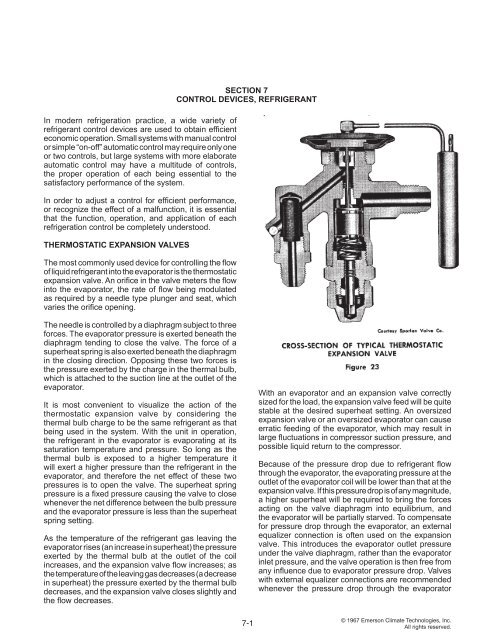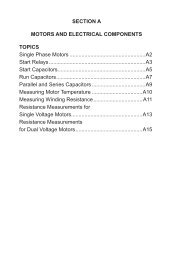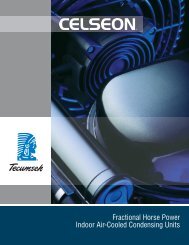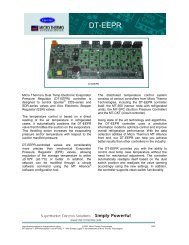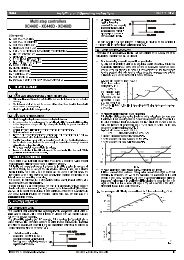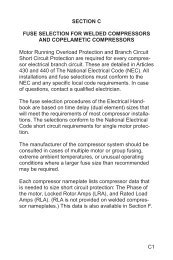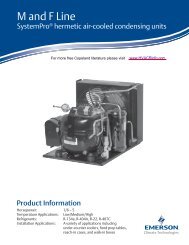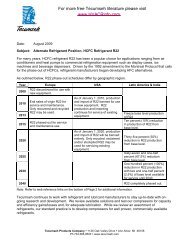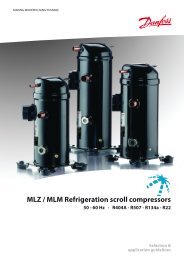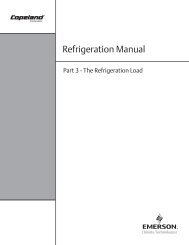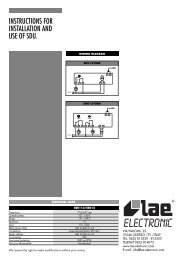Refrigeration Manual - HVAC and Refrigeration Information Links
Refrigeration Manual - HVAC and Refrigeration Information Links
Refrigeration Manual - HVAC and Refrigeration Information Links
Create successful ePaper yourself
Turn your PDF publications into a flip-book with our unique Google optimized e-Paper software.
In modern refrigeration practice, a wide variety ofrefrigerant control devices are used to obtain efficienteconomic operation. Small systems with manual controlor simple “on-off” automatic control may require only oneor two controls, but large systems with more elaborateautomatic control may have a multitude of controls,the proper operation of each being essential to thesatisfactory performance of the system.In order to adjust a control for efficient performance,or recognize the effect of a malfunction, it is essentialthat the function, operation, <strong>and</strong> application of eachrefrigeration control be completely understood.THERMOSTATIC EXPANSION VALVESThe most commonly used device for controlling the flowof liquid refrigerant into the evaporator is the thermostaticexpansion valve. An orifice in the valve meters the flowinto the evaporator, the rate of flow being modulatedas required by a needle type plunger <strong>and</strong> seat, whichvaries the orifice opening.Section 7CONTROL DEVICES, REFRIGERANTThe needle is controlled by a diaphragm subject to threeforces. The evaporator pressure is exerted beneath thediaphragm tending to close the valve. The force of asuperheat spring is also exerted beneath the diaphragmin the closing direction. Opposing these two forces isthe pressure exerted by the charge in the thermal bulb,which is attached to the suction line at the outlet of theevaporator.It is most convenient to visualize the action of thethermostatic expansion valve by considering thethermal bulb charge to be the same refrigerant as thatbeing used in the system. With the unit in operation,the refrigerant in the evaporator is evaporating at itssaturation temperature <strong>and</strong> pressure. So long as thethermal bulb is exposed to a higher temperature itwill exert a higher pressure than the refrigerant in theevaporator, <strong>and</strong> therefore the net effect of these twopressures is to open the valve. The superheat springpressure is a fixed pressure causing the valve to closewhenever the net difference between the bulb pressure<strong>and</strong> the evaporator pressure is less than the superheatspring setting.As the temperature of the refrigerant gas leaving theevaporator rises (an increase in superheat) the pressureexerted by the thermal bulb at the outlet of the coilincreases, <strong>and</strong> the expansion valve flow increases; asthe temperature of the leaving gas decreases (a decreasein superheat) the pressure exerted by the thermal bulbdecreases, <strong>and</strong> the expansion valve closes slightly <strong>and</strong>the flow decreases.With an evaporator <strong>and</strong> an expansion valve correctlysized for the load, the expansion valve feed will be quitestable at the desired superheat setting. An oversizedexpansion valve or an oversized evaporator can causeerratic feeding of the evaporator, which may result inlarge fluctuations in compressor suction pressure, <strong>and</strong>possible liquid return to the compressor.Because of the pressure drop due to refrigerant flowthrough the evaporator, the evaporating pressure at theoutlet of the evaporator coil will be lower than that at theexpansion valve. If this pressure drop is of any magnitude,a higher superheat will be required to bring the forcesacting on the valve diaphragm into equilibrium, <strong>and</strong>the evaporator will be partially starved. To compensatefor pressure drop through the evaporator, an externalequalizer connection is often used on the expansionvalve. This introduces the evaporator outlet pressureunder the valve diaphragm, rather than the evaporatorinlet pressure, <strong>and</strong> the valve operation is then free fromany influence due to evaporator pressure drop. Valveswith external equalizer connections are recommendedwhenever the pressure drop through the evaporator7-1© 1967 Emerson Climate Technologies, Inc.All rights reserved.


